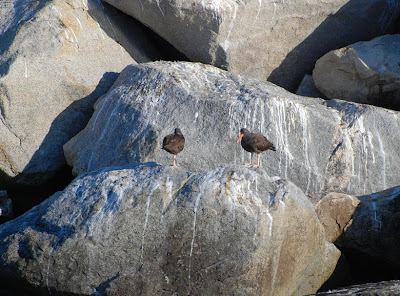I wasn't seriously expecting anything great - probably just Black-vented Shearwaters and Western Gulls - but heck, maybe we'd turn something up. My dad dropped me off at the Ocean Institute at seven-thirty on Saturday morning, and half an hour later the boat was underway. Before we had even departed the harbor, we had spotted Pacific Loons, Glaucous-winged Gulls, and Black Oystercatchers. Oystercatchers are always cool, no matter how many times you see them.

We hadn't gone far before a sharp-eyed birder pointed out the rare Pelagic Christmas-Tree swimming in the water. It was a pity a Christmas Shearwater wasn't sitting on top of it!

Some genuine pelagic birds appeared once we were a mile or two offshore. A smattering of Black-vented Shearwaters cruised by the ship on stiff wings. The boat flushed a couple Rhinoceros Auklets (small grayish birds with an unlikely name) off the water's surface. Several smaller grayish alcids gave us good views of their hindquarters as they desperately struggled to become airborne. Cassin's Auklets aren't very friendly. There was some brief excitement in the stern when a powerful Pomarine Jaeger (undoubtedly very big and squishy - JG) swept through the flock of gulls attending the boat. Nice birds, the whole lot - but ones that I had previously seen in Orange County.
The day took a turn for the better once we were about a dozen miles offshore. A pair of different alcids swimming ahead of the boat turned out to be XANTUS'S MURRELETS. This obscure black-and-white alcid was a life bird for me. This is a Southern Californian specialty, breeding only on the Channel Islands and off Baja California. They were a bit too distant for my three hundred millimeter lens to pull in. When I got home, I told my mom "I got a life bird today - Xantus's Murrelet." "Never heard of it," she replied.

The murrelets would have been enough to make the day noteworthy, but more surprises lay in wait for us. A short time later, a "dark" (read: Sooty/Short-tailed) shearwater sailed by the boat and landed nearby. After extensive study at close range, we positively identified it as a Short-tailed Shearwater. This species is rare in Orange County, though probably more regular than thought because of the dearth of Orange County pelagic trips and also confusion with the more common Sooty Shearwater.

It was difficult to produce any sightings on the level of the Xantus's Murrelets and Short-tailed Shearwater. We tallied more Cassin's Auklets, Rhinocerous Auklets, Pomarine Jaegers, and Black-vented Shearwaters, but the only new species we could find after a few more hours of puttering around the ocean was Common Murre. In the early afternoon, as we chugged back into the harbor, I turned around to see this at eye level.

Looking up, I saw this:

Then this:

And finally, this:

This cheeky first-cycle Western Gull didn't see the point of flying all the way through the harbor, so he decided to just kick back and enjoy a ride on the Sea Explorer while a bunch of weird birders snapped pictures of him from a few feet away.
My birding for the day didn't end when I stepped off the boat. I met my dad on the dock and we drove the short distance to Doheny State Beach, a famous spot for studying gulls. A Glaucous Gull, a big frosty gull with a funky name, had been seen there earlier in the week, and several of the birders on the boat had popped over to Doheney and seen the bird before the boat left in the morning! When we arrived, I started off down the beach, sifting through the hundreds of gulls loafing on the beach. After half and hour, I had seen only the expected species - California, Ring-billed, Heermann's, and Glaucous-wined Gulls. I climbed over a small hill and found several thousand more gulls hanging out in the mouth of the San Juan Creek. Up to now, the search had been manageable; now it was just crazy. Surprisingly, however, I spotted the target bird after only a few minutes. The Glaucous Gull was one of the closest birds, sticking out like a sore thumb: big and white with a bicolored bill. I got a photo of it beside a Glaucous-winged Gull for comparison.

Glaucous Gulls are birds of the north, only rarely wandering as far south as Orange County. This was another new county bird for me, my third for the day: the Xantus's Murrelets and Short-tailed Shearwater were also new. Additionally, I picked out a nice first-cycle Thayer's Gull and several Herring Gulls out of the vast flock, for quite the variety of gulls.
It was a great day. The pelagic trip didn't disappoint, producing a couple great species for Orange County. Additionally, it is always fun to see the more regular pelagic species. Interestingly, The Birds of Orange County: Status and Distribution lists twenty-five as the county high count for Cassin's Auklet; we saw at least three times that number. Very little is known about the seabirds of Orange County! I will jump at the next chance I can get for an Orange County pelagic. The lesson I learned: expect the unexpected, not just Black-vented Shearwaters and Western Gulls!
1 comment:
Awesome! Congrats on the lifer! I sooo need a Pelagic trip.........
Post a Comment